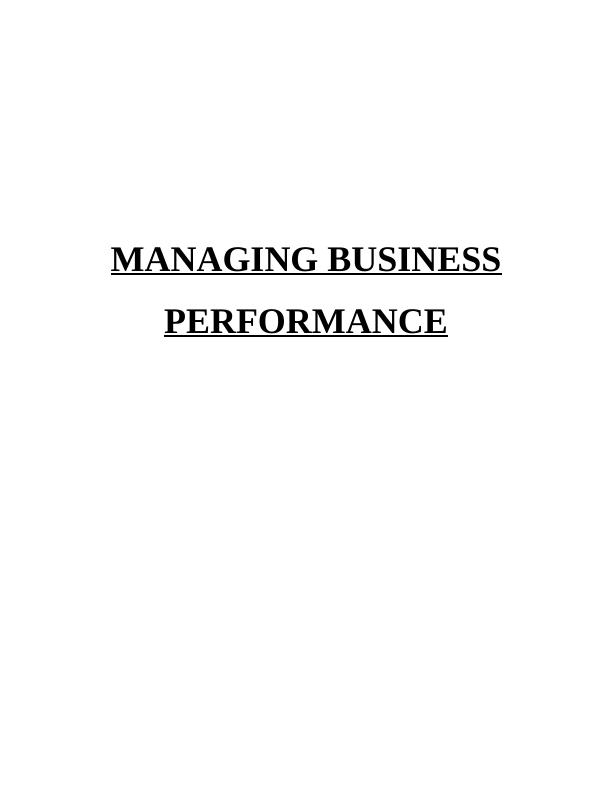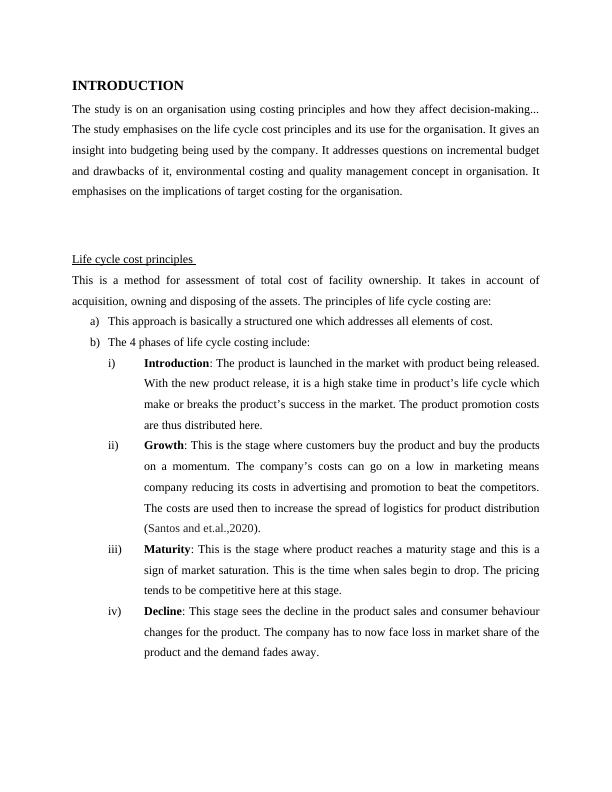Managing Business Performance
Added on 2022-12-23
12 Pages3162 Words93 Views
MANAGING BUSINESS
PERFORMANCE
PERFORMANCE

TABLE OF CONTENTS
INTRODUCTION...........................................................................................................................3
Life cycle cost principles............................................................................................................3
Budget.........................................................................................................................................4
Incremental budgeting.................................................................................................................5
Role of environmental management accounting within modern business environment.............6
Concept of Total Quality Management and its features..............................................................7
Target Cost..................................................................................................................................8
CONCLUSION..............................................................................................................................10
REFERENCES..............................................................................................................................11
INTRODUCTION...........................................................................................................................3
Life cycle cost principles............................................................................................................3
Budget.........................................................................................................................................4
Incremental budgeting.................................................................................................................5
Role of environmental management accounting within modern business environment.............6
Concept of Total Quality Management and its features..............................................................7
Target Cost..................................................................................................................................8
CONCLUSION..............................................................................................................................10
REFERENCES..............................................................................................................................11

INTRODUCTION
The study is on an organisation using costing principles and how they affect decision-making...
The study emphasises on the life cycle cost principles and its use for the organisation. It gives an
insight into budgeting being used by the company. It addresses questions on incremental budget
and drawbacks of it, environmental costing and quality management concept in organisation. It
emphasises on the implications of target costing for the organisation.
Life cycle cost principles
This is a method for assessment of total cost of facility ownership. It takes in account of
acquisition, owning and disposing of the assets. The principles of life cycle costing are:
a) This approach is basically a structured one which addresses all elements of cost.
b) The 4 phases of life cycle costing include:
i) Introduction: The product is launched in the market with product being released.
With the new product release, it is a high stake time in product’s life cycle which
make or breaks the product’s success in the market. The product promotion costs
are thus distributed here.
ii) Growth: This is the stage where customers buy the product and buy the products
on a momentum. The company’s costs can go on a low in marketing means
company reducing its costs in advertising and promotion to beat the competitors.
The costs are used then to increase the spread of logistics for product distribution
(Santos and et.al.,2020).
iii) Maturity: This is the stage where product reaches a maturity stage and this is a
sign of market saturation. This is the time when sales begin to drop. The pricing
tends to be competitive here at this stage.
iv) Decline: This stage sees the decline in the product sales and consumer behaviour
changes for the product. The company has to now face loss in market share of the
product and the demand fades away.
The study is on an organisation using costing principles and how they affect decision-making...
The study emphasises on the life cycle cost principles and its use for the organisation. It gives an
insight into budgeting being used by the company. It addresses questions on incremental budget
and drawbacks of it, environmental costing and quality management concept in organisation. It
emphasises on the implications of target costing for the organisation.
Life cycle cost principles
This is a method for assessment of total cost of facility ownership. It takes in account of
acquisition, owning and disposing of the assets. The principles of life cycle costing are:
a) This approach is basically a structured one which addresses all elements of cost.
b) The 4 phases of life cycle costing include:
i) Introduction: The product is launched in the market with product being released.
With the new product release, it is a high stake time in product’s life cycle which
make or breaks the product’s success in the market. The product promotion costs
are thus distributed here.
ii) Growth: This is the stage where customers buy the product and buy the products
on a momentum. The company’s costs can go on a low in marketing means
company reducing its costs in advertising and promotion to beat the competitors.
The costs are used then to increase the spread of logistics for product distribution
(Santos and et.al.,2020).
iii) Maturity: This is the stage where product reaches a maturity stage and this is a
sign of market saturation. This is the time when sales begin to drop. The pricing
tends to be competitive here at this stage.
iv) Decline: This stage sees the decline in the product sales and consumer behaviour
changes for the product. The company has to now face loss in market share of the
product and the demand fades away.

Coldarin has to follow these phases of life cycle as it will go under the same phase when
launching of new products.
The principles of cost break down structure in which the structure depends according to
purchasing decisions. The objective is related with identification of all cost elements which are
relevant. The structure of cost break down has to be capable of analysing costs specifically.
The cost estimation principle is necessary for computing the costs as per category. The company
Coldarin deals in developing and selling of games. The production costs and the quantity along
with procurement costs have to be computed (Santos and et.al.,2020).
Discounting principle is used to compare costs and benefits occurring in different intervals of
time where people would usually prefer to get goods and services rather than in future. Coldarin
also has to give such benefits to generate sales. The discounts and benefits depending on the
phase of the product life-cycle has to be judged and accordingly the discounts have to be given.
If the product is in maturity stage, company can try to give maximum discounts. The second
factor is of competitor’s strategy which has to be adhered in mind how they are providing offers
and when they are providing them (Gbededo, Liyanage and Garza-Reyes, 2018).
Budget
Volume of 10000 units=130000(cost)
Cost of 1 unit=130000/10000=13
Volume of 14000 units=150000(cost)
Cost of 1 unit=150000/14000=10.71
Fixed Cost Increase=50%
Let us suppose fixed cost to be half of 10.71 i.e. around 5.35.
Fixed cost increase=50% of 5.35i.e. 5.35+2.17=7.52.
Therefore, unit cost will be 13.23.
Design costs have already been written off earlier in income statement so the would not be
included in the budget.
launching of new products.
The principles of cost break down structure in which the structure depends according to
purchasing decisions. The objective is related with identification of all cost elements which are
relevant. The structure of cost break down has to be capable of analysing costs specifically.
The cost estimation principle is necessary for computing the costs as per category. The company
Coldarin deals in developing and selling of games. The production costs and the quantity along
with procurement costs have to be computed (Santos and et.al.,2020).
Discounting principle is used to compare costs and benefits occurring in different intervals of
time where people would usually prefer to get goods and services rather than in future. Coldarin
also has to give such benefits to generate sales. The discounts and benefits depending on the
phase of the product life-cycle has to be judged and accordingly the discounts have to be given.
If the product is in maturity stage, company can try to give maximum discounts. The second
factor is of competitor’s strategy which has to be adhered in mind how they are providing offers
and when they are providing them (Gbededo, Liyanage and Garza-Reyes, 2018).
Budget
Volume of 10000 units=130000(cost)
Cost of 1 unit=130000/10000=13
Volume of 14000 units=150000(cost)
Cost of 1 unit=150000/14000=10.71
Fixed Cost Increase=50%
Let us suppose fixed cost to be half of 10.71 i.e. around 5.35.
Fixed cost increase=50% of 5.35i.e. 5.35+2.17=7.52.
Therefore, unit cost will be 13.23.
Design costs have already been written off earlier in income statement so the would not be
included in the budget.

End of preview
Want to access all the pages? Upload your documents or become a member.
Related Documents
Developing a PLC for two competing products in a same industrylg...
|5
|699
|53
Swedish Medical Center .lg...
|7
|1527
|237
Business Plan Template Project 2022lg...
|29
|6401
|10
Reflective Writing on Industry Evolution and Changelg...
|7
|1307
|121
Individual Products or Services Assignment PDFlg...
|7
|1989
|295
Marketing in International Market | Reportlg...
|8
|2029
|58